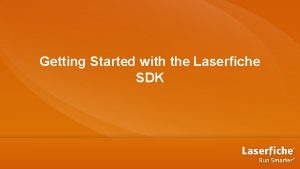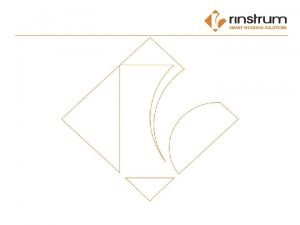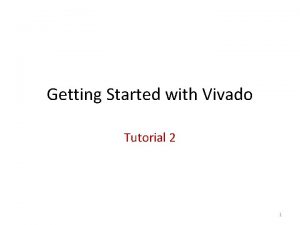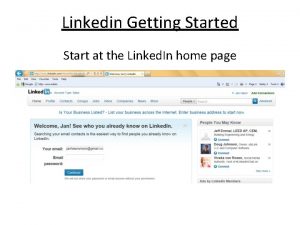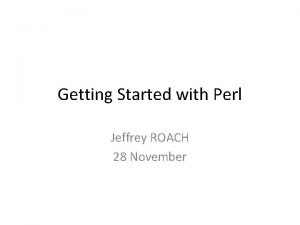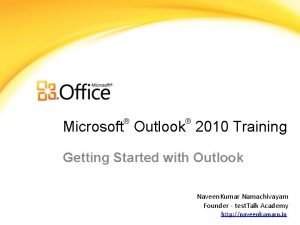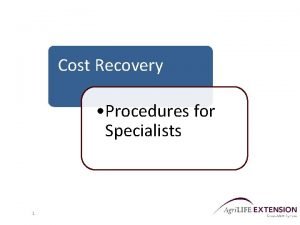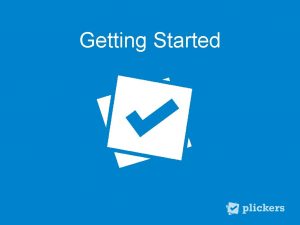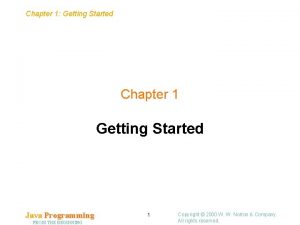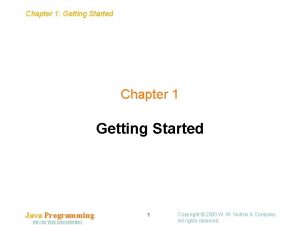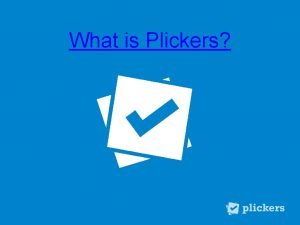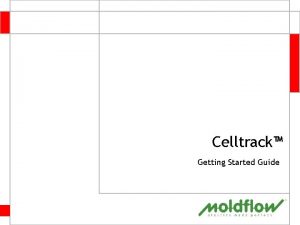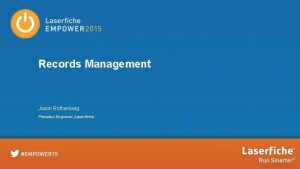Getting Started with the Laserfiche SDK Agenda SDK






















































- Slides: 54

Getting Started with the Laserfiche SDK

Agenda ‣ ‣ SDK overview Demo What you need to know to get started Where to go from here

Prerequisites ‣ Knowledge of Laserfiche architecture ‣ Some programming experience

What is the SDK? ‣ Tools you can use to create custom applications that access Laserfiche • Libraries • Distribution tools • Documentation

What Can You Do with the SDK? ‣ Create applications that work with… • The repository • Documents • The Laserfiche Client user interface

SDK Libraries

SDK Libraries ‣. NET • Repository Access • Document Services • Client Automation Tools ‣ COM, Java libraries available

Repository Access ‣ ‣ Connections Metadata Entries Administration

Document Services ‣ Import/Export documents ‣ Generate text

Client Automation Tools ‣ Control UI ‣ Scan ‣ Integrate Laserfiche and other applications

Quick Demo!

Demo Overview ‣ ‣ ‣ Logging in and out Working with entries Modifying field values Locking and saving Searching

Basic Demo Recap ‣ Returned name and field values for an entry

Behind the Scenes ‣ Logged in ‣ Found an entry • Found its field information ‣ Logged out

Demo Code Repository. Registration my. Repo. Reg = new Repository. Registration(“localhost", “Laser. Investigators"); Session my. Sess = new Session(); my. Sess. Log. In(my. Repo. Reg); Console. Write. Line("Entry ID: "); //asks for entry ID int entry. Id = int. Parse(Console. Read. Line()); Entry. Info my. Entry = Entry. Get. Entry. Info(entry. Id, my. Sess); // get an entry Console. Write. Line(my. Entry. Name); Field. Value. Collection my. Fields = my. Entry. Get. Field. Values(); for (int i = 0; i < my. Fields. Count; i++) { Console. Write. Line(my. Fields. Position. To. Name(i) + ": " + my. Fields[i]); } my. Entry. Dispose(); //disposes of the object my. Sess. Close(); //logs out and disconnects from Laserfiche

Common SDK Tasks

SDK Building 101 ‣ ‣ ‣ Log in Lock the documents to be worked on Perform the actions Save the changes Release the locks Log out

Logging In ‣ Create a Session() object • Windows or Laserfiche authentication • Can use SSL • You’ll use this frequently

Logging In Repository. Registration my. Repo. Reg = new Repository. Registration("Server", "Repository"); Session my. Sess = new Session(); my. Sess. Log. In("username", "password", my. Repo. Reg); ‣ To use Windows authentication, do not pass username/password to the. Log. In() method

After Logging In… ‣ Work with • • Templates Users Entries And more

Working with Entries ‣ Use a static class to create an info object • Many methods available ‣ Use Entry class to get Entry. Info object, use Document class to get Document. Info object, etc.

Working with an Entry Object Entry. Info my. Entry = Entry. Get. Entry. Info(entry. Id, my. Sess); Console. Write. Line(my. Entry. Name); Other properties include: ‣. Id, . Owner, . Path, . Template. Name

Getting Field Values ‣ Just like entries, there are objects that represent metadata Field. Value. Collection my. Fields = my. Entry. Get. Field. Values(); for (int i = 0; i < my. Fields. Count; i++) { Console. Write. Line(my. Fields. Position. To. Name(i) + ": " + my. Fields[i]); }

Summary Repository. Registration my. Repo. Reg = new Repository. Registration(“localhost", “Laser. Investigators"); Session my. Sess = new Session(); my. Sess. Log. In(my. Repo. Reg); Console. Write. Line("Entry ID: "); //asks for entry ID int entry. Id = int. Parse(Console. Read. Line()); Entry. Info my. Entry = Entry. Get. Entry. Info(entry. Id, my. Sess); // get an entry Console. Write. Line(my. Entry. Name); Field. Value. Collection my. Fields = my. Entry. Get. Field. Values(); for (int i = 0; i < my. Fields. Count; i++) { Console. Write. Line(my. Fields. Position. To. Name(i) + ": " + my. Fields[i]); } my. Entry. Dispose(); //disposes of the object my. Sess. Close(); //logs out and disconnects from Laserfiche

Searching Demo Overview

Searching Demo Overview ‣ Searched for an entry by its name ‣ For each result, updated a field with a value we specified

Behind the Scenes ‣ Logged in ‣ Searched for entries by name ‣ For each entry found • • Locked the entry Added a value for the name field Saved the changes Unlocked the entry ‣ Logged out

Searching ‣ Create a Search object ‣ Use advanced search syntax with the. Command property ‣ Use the. Run method to begin the search

Searching Code Example Search my. Search = new Search(my. Sess); my. Search. Command = "{[]: [Investigator Assigned]="" + old. Investigator +""}"; my. Search. Run();

Search Statistics ‣ Create a Search. Statistics object to find useful information about your search • Document/folder/page/shortcut count • Text/image file size

Search Statistics Code Example Search. Statistics search. Statistics = my. Search. Get. Summary. Stats(); Console. Write. Line("Entries Found: " + search. Statistics. Document. Count);

Working with Search Results ‣ Create a Search. Listing. Settings object to specify the result data you want ‣ Use. Get. Result. Listing to create a Search. Result. Listing object

Search Results Code Example Search. Listing. Settings settings = new Search. Listing. Settings(); Search. Result. Listing results = my. Search. Get. Result. Listing(settings);

Working with Search Results ‣ Use Search. Result. Listing to find the information you want ‣ Sample app iterated through each result and modified the entry

Working with Search Results Code for (int k = 1; k <= results. Rows. Count; k++) { int entry. Id = (int)results. Get. Datum(k, System. Column. Id); Console. Write. Line(entry. Id + " " + results. Get. Datum. As. String(k, System. Column. Name)); Entry. Info my. Entry = Entry. Get. Entry. Info(entry. Id, my. Sess); Field. Value. Collection my. Fields = my. Entry. Get. Field. Values(); my. Fields["Investigator Assigned"] = new. Investigator; my. Entry. Lock(Lock. Type. Exclusive); my. Entry. Set. Field. Values(my. Fields); my. Entry. Save(); my. Entry. Unlock(); my. Entry. Dispose(); }

Working with Search Results Code for (int k = 1; k <= results. Rows. Count; k++) { int entry. Id = (int)results. Get. Datum(k, System. Column. Id); Console. Write. Line(entry. Id + " " + results. Get. Datum. As. String(k, System. Column. Name)); Entry. Info my. Entry = Entry. Get. Entry. Info(entry. Id, my. Sess); Field. Value. Collection my. Fields = my. Entry. Get. Field. Values(); my. Fields["Name"] = name; my. Entry. Lock(Lock. Type. Exclusive); my. Entry. Set. Field. Values(my. Fields); my. Entry. Save(); my. Entry. Unlock(); my. Entry. Dispose(); }

Locking and Saving Entries ‣ You must lock an entry before you modify it ‣ Save your changes

Locking and Saving Code Example my. Entry. Lock(Lock. Type. Exclusive); //lock the entry my. Entry. Set. Field. Values(my. Fields); //modify it my. Entry. Save(); //save your changes my. Entry. Unlock(); //unlock the entry my. Entry. Dispose(); //get rid of the entry object

Summary

Write Robust Code ‣ These sample apps work in a perfect environment ‣ Use try-catch statements to handle the unexpected

Deployment!

Distribution Tools ‣ Run-time installer ‣ Merge modules

Run-Time Installer ‣ Use the installer that comes with the SDK, then copy your application over

Merge Modules ‣ Used with your installer to deliver only the components you need

Resources!

Resources ‣ SDK Documentation • Tutorials • Sample projects • Object references ‣ Legacy SDK libraries

More Resources ‣ Solution Exchange ‣ Support Site • Code Library • Answers Site

Solution Exchange

Support Site

Code Library

Answers

Further Learning ‣ EDM 203: Effective Integration Strategies ‣ CD 251: Using the Laserfiche UI in Your Integration ‣ CC 302: Capture and Classification with the SDK ‣ EDM 351: Advanced Applied SDK

Questions?

Further Learning ‣ EDM 203: Effective Integration Strategies ‣ CD 251: Using the Laserfiche UI in Your Integration ‣ CC 302: Capture and Classification with the SDK ‣ EDM 351: Advanced Applied SDK
 The secret to getting ahead is getting started
The secret to getting ahead is getting started Laserfiche search syntax
Laserfiche search syntax Counter code
Counter code Android development getting started
Android development getting started Find these things in unit 1
Find these things in unit 1 Rancher slack
Rancher slack Unit 3 getting started
Unit 3 getting started Lua getting started
Lua getting started Tipos de habilidades del pensamiento
Tipos de habilidades del pensamiento Getting started with vivado ip integrator
Getting started with vivado ip integrator Linkedin getting started
Linkedin getting started Getting started with excel
Getting started with excel Unit 1 getting started
Unit 1 getting started English 7 unit 1 getting started
English 7 unit 1 getting started Unix for bioinformatics
Unix for bioinformatics Getting started with eclipse
Getting started with eclipse Perl read_file
Perl read_file Getting started with vivado
Getting started with vivado Outlook 2010 tutorial
Outlook 2010 tutorial Poll everywhere register
Poll everywhere register Local environment getting started
Local environment getting started Splunk getting started
Splunk getting started Mathematica getting started
Mathematica getting started Getting started with ft8
Getting started with ft8 Laserfiche tamu
Laserfiche tamu Laserfiche process automation
Laserfiche process automation Laserfiche training program
Laserfiche training program Laserfiche var
Laserfiche var Agenda sistemica y agenda institucional
Agenda sistemica y agenda institucional Một số thể thơ truyền thống
Một số thể thơ truyền thống Các châu lục và đại dương trên thế giới
Các châu lục và đại dương trên thế giới Thế nào là hệ số cao nhất
Thế nào là hệ số cao nhất Sơ đồ cơ thể người
Sơ đồ cơ thể người Ng-html
Ng-html Thế nào là số nguyên tố
Thế nào là số nguyên tố Tư thế ngồi viết
Tư thế ngồi viết đặc điểm cơ thể của người tối cổ
đặc điểm cơ thể của người tối cổ Mật thư tọa độ 5x5
Mật thư tọa độ 5x5 Tư thế worm breton
Tư thế worm breton ưu thế lai là gì
ưu thế lai là gì Thẻ vin
Thẻ vin Bàn tay mà dây bẩn
Bàn tay mà dây bẩn Các châu lục và đại dương trên thế giới
Các châu lục và đại dương trên thế giới Từ ngữ thể hiện lòng nhân hậu
Từ ngữ thể hiện lòng nhân hậu Bổ thể
Bổ thể Tư thế ngồi viết
Tư thế ngồi viết Diễn thế sinh thái là
Diễn thế sinh thái là Thứ tự các dấu thăng giáng ở hóa biểu
Thứ tự các dấu thăng giáng ở hóa biểu Phép trừ bù
Phép trừ bù Thơ thất ngôn tứ tuyệt đường luật
Thơ thất ngôn tứ tuyệt đường luật Hát lên người ơi alleluia
Hát lên người ơi alleluia Khi nào hổ con có thể sống độc lập
Khi nào hổ con có thể sống độc lập đại từ thay thế
đại từ thay thế Vẽ hình chiếu vuông góc của vật thể sau
Vẽ hình chiếu vuông góc của vật thể sau Công của trọng lực
Công của trọng lực

